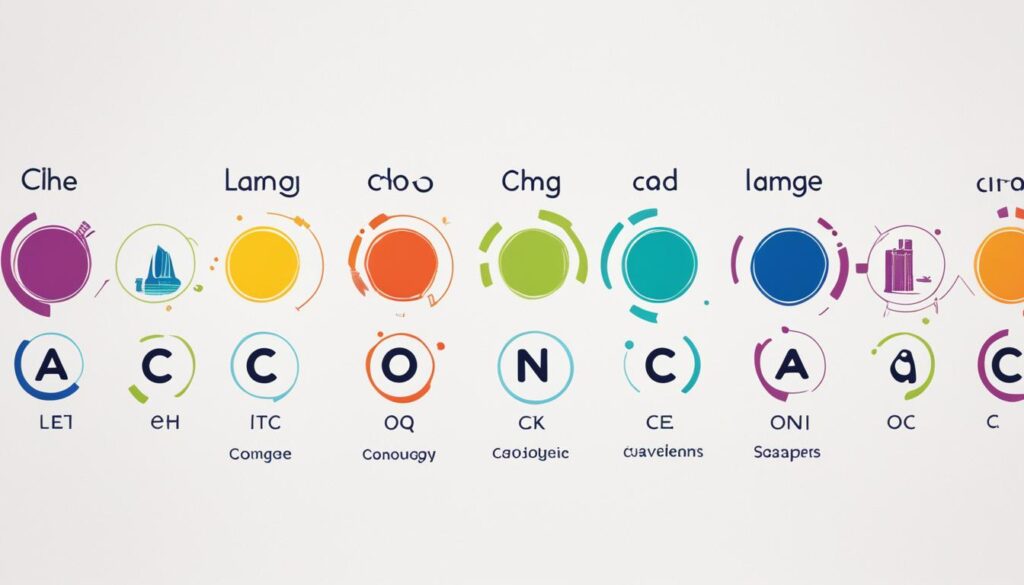Did you know that the Chong language, also known as Chawng, Shong, or Xong, is an endangered language spoken in eastern Thailand and formerly in Cambodia by the Chong people? This unique language belongs to the Western Pearic language group in the Mon-Khmer language family and is currently undergoing a revitalization project in Thailand. Let’s dive deeper into the fascinating world of the Chong language.
Chong Language Dialects
The Chong language, also known as Chawng, Shong, or Xong, consists of two main dialects: Western Chong and Central Chong, also known as Samre.
The Western Chong community is primarily located in and around Chanthaburi in Thailand. This dialect is spoken by a significant number of Chong people and has its own unique characteristics and vocabulary.
Within Western Chong, there are sub-dialects, including the Kasong dialect in Trat Province. These sub-dialects may have variations in pronunciation, vocabulary, and grammar, influenced by geographical and cultural factors.
Central Chong, also known as Samre, is another dialect spoken by the Chong community. Though it shares many similarities with Western Chong, there are distinct differences that set it apart.
“The Chong dialects should not be confused with other languages or dialects that also bear the name Chong, such as the variety in Trat Province or the dialects of Samre and Sa’och.”
Comparison of Chong Dialects
| Western Chong | Central Chong (Samre) | |
|---|---|---|
| Geographical Location | Primarily in and around Chanthaburi | Variety of areas |
| Main Sub-Dialect | Kasong dialect in Trat Province | N/A |
| Key Characteristics | Distinct vocabulary and expressions | Shared features with Western Chong |
Table 2: Comparison of Chong Dialects
Although these dialects exist, it is important to note that they should be distinguished from other languages or dialects that are also referred to as Chong. Each dialect offers valuable insights into the culture and identity of the Chong community and contributes to the linguistic diversity of the region.
Chong Language Features
The Chong language is known for its unique features that distinguish it from other languages. One of the remarkable characteristics of the Chong language is its four-way contrast in register, making it stand out among many other languages.
The Chong language is characterized by its four-way contrast in register, which sets it apart from many other languages.
While the grammar of Chong has not been extensively studied, it is important to note that it is not related to the Thai language, which belongs to the Tai-Kadai language family. This distinction makes Chong a fascinating language to explore and investigate further.
Before the year 2000, Chong had no written form. However, researchers at Mahidol University developed a simplified version of the Thai writing system for Chong. This writing system has opened up new possibilities for language preservation and education, allowing the creation of teaching materials that facilitate the study of the Chong language.
Chong Language Features:
| Feature | Description |
|---|---|
| Register Contrast | The Chong language exhibits a four-way contrast in register, a unique feature that distinguishes it from many other languages. |
| Grammar | The grammar of Chong has not been extensively studied but is distinct from the Thai language, which belongs to the Tai-Kadai language family. |
| Writing System | Before 2000, Chong had no written form, but a simplified version of the Thai writing system has been developed for the language. |
These features make the Chong language an intriguing area of study for linguists and language enthusiasts alike.
Chong Language Revitalization
The Chong Language of Thailand is currently the focus of a comprehensive language revitalization project. This project aims to preserve and promote the Chong language, which is endangered, by developing various language resources, study materials, and online courses. The primary goal is to raise awareness about the importance of Chong language and culture and provide opportunities for people to learn and use the language.
The Chong Language revitalization project is an essential initiative that recognizes the cultural significance and value of language preservation. By actively engaging in this project, individuals can contribute to the preservation and revitalization of the Chong Language, ensuring its survival for future generations to come.
“Language revitalization plays a crucial role in preserving the unique cultural heritage of the Chong community. Through the development of language resources, study materials, and online courses, we are creating a supportive environment for those interested in learning and using the Chong language. This project is a vital step in preserving our language and enriching our community’s cultural identity.”
The Chong Language revitalization project provides a range of language study materials and resources, catering to learners of various proficiency levels. These resources include textbooks, audio recordings, vocabulary lists, and grammar guides, allowing individuals to engage in self-study and develop their language skills.
Furthermore, online courses are being developed to provide a structured learning experience for those interested in actively participating in Chong language learning. These courses cover essential language skills such as listening, speaking, reading, and writing, enabling learners to gain a comprehensive understanding of the Chong Language.
Through the collective efforts of language experts, educators, and community members, the Chong Language revitalization project strives to reinvigorate the use of Chong language in everyday life. By creating accessible language resources and educational opportunities, the project aims to empower individuals to learn, use, and appreciate the Chong Language.
The Importance of Language Preservation
Preserving endangered languages like Chong is vital for several reasons:
- Language preservation ensures the cultural heritage of the Chong community.
- Language is deeply intertwined with identity and plays a crucial role in expressing cultural nuances and traditions.
- Language preservation fosters intergenerational connections, enabling younger generations to connect with their cultural roots.
- It contributes to the overall linguistic diversity and richness of the global community.
Efforts to revitalize the Chong Language highlight the significance of language preservation and the importance of cherishing and celebrating linguistic diversity.
In conclusion, the Chong Language revitalization project is a significant endeavor dedicated to the preservation and promotion of the Chong language. By providing language resources, study materials, and online courses, this project aims to raise awareness, empower learners, and ensure the longevity of the Chong Language for generations to come.

Chong Language in Thailand and Cambodia
While the Chong language in Thailand has been studied to some extent, there has been relatively little attention given to the Chong language in Cambodia. According to a report by David Bradley, there are no remaining speakers of the Chong language in Cambodia. This alarming fact highlights the endangered status of the language and the urgent need for language documentation and preservation efforts in both Thailand and Cambodia.
The Chong language is not only an integral part of the Chong community’s cultural heritage but also a valuable linguistic resource. Documenting the language is crucial for preserving its unique features, grammar, and vocabulary, as well as understanding its historical and cultural significance.
In Thailand, efforts have been made to revitalize the Chong language through language preservation projects and educational initiatives. These initiatives aim to raise awareness about the importance of the language and provide resources such as dictionaries, study materials, and online courses to promote its learning and usage.
However, the situation in Cambodia calls for immediate action. Without speakers and adequate documentation, the Chong language faces a severe threat of extinction. It is essential to prioritize language documentation efforts in Cambodia, working closely with the Chong community to record and preserve their language for future generations.
“Preserving endangered languages like Chong is not only a matter of linguistic diversity but also a vital means of safeguarding cultural heritage and promoting cross-cultural understanding.” – Linguist Sarah Nguyen
Efforts should be made to establish collaborations between linguists, researchers, and the Chong communities in both Thailand and Cambodia. Language documentation projects can involve linguistic fieldwork, recording oral histories, creating bilingual materials, and working closely with community members to ensure an accurate and comprehensive representation of the Chong language.
Chong Language Documentation Challenges
Documenting endangered languages like Chong is not without its challenges. Some of the common challenges include:
- Limited funding and resources
- Access to fluent speakers and community cooperation
- The need for specialized linguistic expertise
- Preserving language variation and dialectal differences
- Developing sustainable language documentation programs
Despite these challenges, the urgency of preserving the Chong language cannot be understated. Efforts to document the language will contribute not only to the preservation of a unique linguistic heritage but also to the cultural identity and pride of the Chong people.
The Importance of Language Documentation
Language documentation plays a critical role in linguistics and cultural studies. It serves as a valuable resource for future research, language revitalization efforts, and community development. By documenting endangered languages like Chong, we can prevent the loss of linguistic diversity and promote cross-cultural understanding.
The documentation of the Chong language in both Thailand and Cambodia requires collaborative efforts, support from academic institutions, and recognition of the cultural and linguistic rights of indigenous communities. It is a collective responsibility to ensure that endangered languages are not forgotten but celebrated and preserved for generations to come.
Chong Language Phonology
The Chong language exhibits a unique phonology characterized by a diverse range of consonant and vowel sounds. Understanding the phonetic inventory is crucial in comprehending the nuances of this endangered language.
Chong Consonants
In Chong, consonants encompass various sounds, including bilabial, alveolar, palatal, velar, and glottal. These phonemes contribute to the distinctive pronunciation of words and form the foundation of Chong speech.
Chong Vowels
Vowels in the Chong language are categorized into front, central, and back sounds. This classification system allows for precise pronunciation and emphasizes the importance of vocal quality in conveying meaning.
Just as every brushstroke contributes to the masterpiece, every phoneme in the Chong language colors the linguistic tapestry.
To further explore the detailed phonetic inventory and study resources on Chong language phonology, please refer to linguistic studies dedicated to this fascinating language.

| Chong Consonants | Chong Vowels |
|---|---|
| Consonant 1 | Vowel 1 |
| Consonant 2 | Vowel 2 |
| Consonant 3 | Vowel 3 |
Multilingual Situation in Thailand
Thailand is a diverse country with a rich linguistic landscape. While Standard Thai is the official language and widely spoken, there are also numerous minority languages spoken across the country. These minority languages add to the cultural tapestry of Thailand, reflecting the unique heritage and traditions of different ethnic groups.
However, the multilingualism in Thailand is facing challenges, with many minority languages experiencing decline and some even facing the threat of extinction. The encroachment of the dominant language, limited resources for language preservation, and shifting cultural dynamics contribute to the gradual erosion of these languages.
Efforts are being made to raise awareness about the importance of multilingualism in Thailand and the need to preserve linguistic diversity. Language revitalization projects, educational initiatives, and community-driven programs are being implemented to document, teach, and celebrate minority languages.
It is crucial to recognize the value of these minority languages as part of Thailand’s intangible cultural heritage. By promoting their preservation, we not only honor the linguistic heritage of diverse communities but also foster inclusivity and maintain the authenticity of Thailand’s cultural identity.
| Challenges | Actions |
|---|---|
| Limited resources for language preservation | Educational initiatives and fundraising campaigns to support language documentation and revitalization projects. |
| Encroachment of the dominant language | Efforts to promote bilingual education and encourage the use of minority languages in schools and communities. |
| Shifting cultural dynamics | Creation of language learning materials, digital resources, and online courses to enhance access and interest in minority languages. |
Preserving multilingualism in Thailand is not only about linguistic diversity but also about acknowledging and celebrating the cultural richness of the country. It helps in creating a more inclusive and harmonious society where all languages and ethnicities are recognized and valued.
Conclusion
The Chong Language of Thailand is a valuable cultural asset that is currently at risk of extinction. The language holds significant cultural significance for the Chong community, representing their heritage and identity. Recognizing the importance of preserving this unique language, efforts have been made to revitalize and protect it through language preservation projects and the development of educational resources.
By learning and preserving the Chong Language, we can contribute to the safeguarding of a rich cultural heritage and forge connections with the Chong community. Language preservation is not just about words and grammar; it is about keeping alive traditions, stories, and an entire way of life. Through language learning resources and courses, individuals can actively engage in the preservation of the Chong Language and participate in the revitalization efforts.
As a community, it is crucial to support the initiatives aimed at Chong Language revitalization. By celebrating and valuing linguistic diversity, we can ensure that future generations have the opportunity to learn and appreciate the Chong Language. Together, we can make a difference in preserving this endangered language and maintaining the cultural heritage of the Chong community for years to come.
FAQ
What is the Chong Language?
The Chong language, also known as Chawng, Shong, or Xong, is an endangered language spoken in eastern Thailand and formerly in Cambodia by the Chong people.
How many dialects does the Chong Language have?
The Chong language has two main dialects: Western Chong and Central Chong, also known as Samre. There are also sub-dialects within Western Chong, such as the Kasong dialect in Trat Province.
What are some unique features of the Chong Language?
The Chong language is known for its four-way contrast in register and has a distinct grammar unrelated to the Thai language. Additionally, a simplified version of the Thai writing system has been developed for Chong.
Are there any efforts being made to revitalize the Chong Language?
Yes, the Chong Language is currently the focus of a language revitalization project in Thailand. Efforts are being made to preserve and promote the language through the development of resources, study materials, and online courses.
What is the status of the Chong Language in Thailand and Cambodia?
While the Chong language in Thailand is undergoing revitalization efforts, the Chong language in Cambodia has not received much attention and has no remaining speakers according to reports.
What is the phonology of the Chong Language?
The Chong language has a distinct phonology with various consonant and vowel sounds. Consonants include bilabial, alveolar, palatal, velar, and glottal sounds, while vowels are categorized into front, central, and back sounds.
What is the linguistic landscape like in Thailand?
Thailand is a diverse country with a rich linguistic landscape. While Standard Thai is the official language, there are numerous minority languages spoken across the country. However, many of these minority languages are in decline or facing the threat of extinction.
Why is it important to learn and preserve the Chong Language?
Learning and preserving the Chong language contribute to the preservation of a rich cultural heritage and help to connect with the Chong community. Efforts are being made to develop resources and educational materials to support language learning and preservation.
